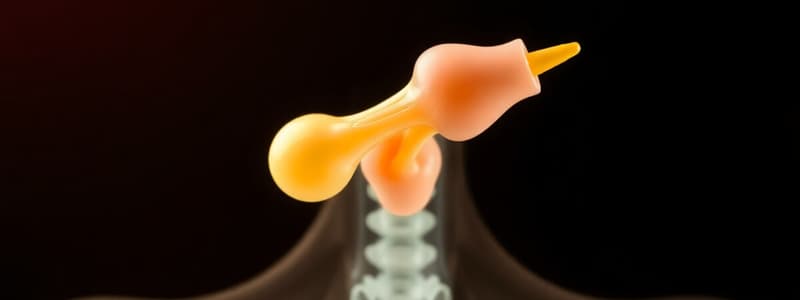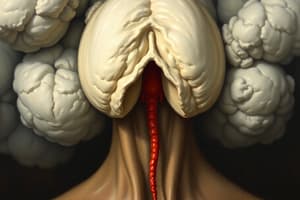Podcast
Questions and Answers
What is the primary function of the growth hormone in the body?
What is the primary function of the growth hormone in the body?
- Mediating growth and metabolic functions (correct)
- Enhancing the immune response
- Stimulating the production of red blood cells
- Regulating calcium levels in the blood
Which of the following statements correctly describes the anterior pituitary?
Which of the following statements correctly describes the anterior pituitary?
- It is an avascular structure.
- It arises from pharyngeal epithelium as Rathke's pouch. (correct)
- It is directly responsible for regulating the secretion of thyroid hormones.
- It develops from the neuroectoderm.
How is growth hormone secretion regulated?
How is growth hormone secretion regulated?
- It is primarily based on genetic factors inherited from parents.
- It is regulated solely by feedback from peripheral organs.
- It occurs independently of the hypothalamus.
- It is influenced by hypothalamic hormones and physiologic demands. (correct)
What is the role of insulin-like growth factor I (IGF-I) in relation to growth hormone?
What is the role of insulin-like growth factor I (IGF-I) in relation to growth hormone?
What embryological origin does the posterior pituitary have?
What embryological origin does the posterior pituitary have?
What is the pars intermedia?
What is the pars intermedia?
What term describes the relationship between the hypothalamus and the pituitary gland?
What term describes the relationship between the hypothalamus and the pituitary gland?
How does the anterior pituitary receive signals for hormone secretion?
How does the anterior pituitary receive signals for hormone secretion?
What percentage of chromophil cells in the anterior pituitary are somatotropes that secrete growth hormone?
What percentage of chromophil cells in the anterior pituitary are somatotropes that secrete growth hormone?
Which of the following hormones is not classified as a glycoprotein secreted by the anterior pituitary?
Which of the following hormones is not classified as a glycoprotein secreted by the anterior pituitary?
Which type of cell in the anterior pituitary is known to be non-secretory and serves as a precursor to chromophil cells?
Which type of cell in the anterior pituitary is known to be non-secretory and serves as a precursor to chromophil cells?
The anterior pituitary is referred to as the master gland primarily because it regulates which of the following?
The anterior pituitary is referred to as the master gland primarily because it regulates which of the following?
Which type of anterior pituitary cell is classified as basophilic and secretes adrenocorticotropic hormone (ACTH)?
Which type of anterior pituitary cell is classified as basophilic and secretes adrenocorticotropic hormone (ACTH)?
What is the main difference between acidophil and basophil cells in the anterior pituitary?
What is the main difference between acidophil and basophil cells in the anterior pituitary?
What peptide hormone is secreted by lactotropes in the anterior pituitary?
What peptide hormone is secreted by lactotropes in the anterior pituitary?
Which of the following statements about the anterior pituitary gland is true?
Which of the following statements about the anterior pituitary gland is true?
What is the primary function of the first 24 amino acids in adrenocorticotropic hormone (ACTH)?
What is the primary function of the first 24 amino acids in adrenocorticotropic hormone (ACTH)?
Which hormone from the hypothalamus inhibits the release of growth hormone?
Which hormone from the hypothalamus inhibits the release of growth hormone?
Which hormone is primarily responsible for stimulating the anterior pituitary to release adrenocorticotropic hormone (ACTH)?
Which hormone is primarily responsible for stimulating the anterior pituitary to release adrenocorticotropic hormone (ACTH)?
Which of the following hormones secreted by the anterior pituitary is categorized as a tropic hormone?
Which of the following hormones secreted by the anterior pituitary is categorized as a tropic hormone?
What is the role of releasing and inhibitory hormones secreted by the hypothalamus?
What is the role of releasing and inhibitory hormones secreted by the hypothalamus?
Which two hormones are primarily stimulated by gonadotropin-releasing hormone (GnRH)?
Which two hormones are primarily stimulated by gonadotropin-releasing hormone (GnRH)?
What is the function of beta endorphin in the body?
What is the function of beta endorphin in the body?
How are the releasing hormones from the hypothalamus transported to the anterior pituitary?
How are the releasing hormones from the hypothalamus transported to the anterior pituitary?
Flashcards
What is the pituitary gland?
What is the pituitary gland?
The pituitary gland, also known as the hypophysis, is a small endocrine gland located in the sella turcica, a depression within the sphenoid bone at the base of the skull. It is connected to the hypothalamus by the pituitary stalk, or hypophyseal stalk.
What are the two main parts of the pituitary gland?
What are the two main parts of the pituitary gland?
The pituitary gland is divided into two main parts: the anterior pituitary (adenohypophysis) and the posterior pituitary (neurohypophysis). These divisions are located close to each other but have different origins, structures, and functions.
What is the pars intermedia?
What is the pars intermedia?
The pars intermedia is a small, relatively avascular structure located between the anterior and posterior pituitary.
How does the anterior pituitary develop?
How does the anterior pituitary develop?
Signup and view all the flashcards
How does the posterior pituitary develop?
How does the posterior pituitary develop?
Signup and view all the flashcards
What is the hypothalamo-hypophyseal relationship?
What is the hypothalamo-hypophyseal relationship?
Signup and view all the flashcards
How are hormones transported to the anterior and posterior pituitary?
How are hormones transported to the anterior and posterior pituitary?
Signup and view all the flashcards
What is the overall relationship between the anterior and posterior pituitary?
What is the overall relationship between the anterior and posterior pituitary?
Signup and view all the flashcards
ACTH and Skin Pigmentation
ACTH and Skin Pigmentation
Signup and view all the flashcards
Beta-Endorphin: The Body's Natural Painkiller
Beta-Endorphin: The Body's Natural Painkiller
Signup and view all the flashcards
Hypothalamus-Pituitary Connection
Hypothalamus-Pituitary Connection
Signup and view all the flashcards
Hormone Release from the Hypothalamus
Hormone Release from the Hypothalamus
Signup and view all the flashcards
Role of GHRH
Role of GHRH
Signup and view all the flashcards
Role of GHIH
Role of GHIH
Signup and view all the flashcards
Role of TRH
Role of TRH
Signup and view all the flashcards
Tropic Hormones: Regulating Other Glands
Tropic Hormones: Regulating Other Glands
Signup and view all the flashcards
What is the anterior pituitary gland?
What is the anterior pituitary gland?
Signup and view all the flashcards
What are the parts of the anterior pituitary?
What are the parts of the anterior pituitary?
Signup and view all the flashcards
What are the types of cells in the anterior pituitary?
What are the types of cells in the anterior pituitary?
Signup and view all the flashcards
How are chromophil cells classified?
How are chromophil cells classified?
Signup and view all the flashcards
What hormones do the specialized chromophil cells produce?
What hormones do the specialized chromophil cells produce?
Signup and view all the flashcards
What is the difference between acidophilic and basophilic cells?
What is the difference between acidophilic and basophilic cells?
Signup and view all the flashcards
How are anterior pituitary hormones classified?
How are anterior pituitary hormones classified?
Signup and view all the flashcards
What is an acidophilic tumor?
What is an acidophilic tumor?
Signup and view all the flashcards
Study Notes
Pituitary Gland Objectives
- After studying lectures 2&3, students should be able to describe the pituitary gland's structure and its relationship to function.
- Define pituitary cell types, understand how their numbers are regulated by physiological demands, and describe the effects of growth hormone on growth and metabolism.
- Define the role of Insulin-like Growth Factor I in mediating growth hormone actions.
- List stimuli that regulate growth hormone secretion and explain the underlying mechanisms.
- Understand abnormal pituitary function and growth hormone secretion, and how these conditions are treated.
Pituitary Gland Introduction
- The pituitary gland, also called the hypophysis, is a small endocrine gland (1 cm in diameter, weighing 0.5-1 g).
- It's located in the sella turcica of the sphenoid bone at the base of the skull.
- It's connected to the hypothalamus by the pituitary stalk (hypophyseal stalk).
- The pituitary gland is divided into two divisions: anterior pituitary (adenohypophysis) and posterior pituitary (neurohypophysis).
- These divisions, though close, arise from different embryonic origins (ectoderm vs. neuroectoderm).
- They have distinct structures and functions.
- A small, relatively avascular structure, called the pars intermedia, lies between the two divisions.
Pituitary Gland Anatomy and Development
- Both anterior and posterior pituitary divisions develop embryologically from different sources.
- The anterior pituitary arises from the pharyngeal epithelium (upward growth—Rathke's pouch).
- The posterior pituitary originates from the hypothalamus as a downward diverticulum.
- These two parts grow towards each other and fuse in the median region between the mouth cavity and brain.
Anterior Pituitary (Adenohypophysis) - Histology
- The anterior pituitary has two major cell types: chromophobe cells and chromophil cells.
- Chromophobe cells (50%): do not contain granules and stain poorly. They are thought to be precursor cells for chromophil cells.
- Chromophil cells (50%): contain granules and stain darkly. These are further classified based on staining properties or secretory nature.
Anterior Pituitary Cell Types (Chromophil Cells)
- Classification by staining:
- Acidophilic (alpha cells, ~35%): stain acidophilically.
- Basophilic (beta cells, ~15%): stain basophilically.
- Classification by secretory nature:
- Somatotropes: secrete growth hormone (GH).
- Corticotropes: secrete adrenocorticotropic hormone (ACTH).
- Thyrotropes: secrete thyroid-stimulating hormone (TSH).
- Gonadotropes: secrete follicle-stimulating hormone (FSH) and luteinizing hormone (LH).
- Lactotropes: secrete prolactin.
Regulation of Anterior Pituitary Secretion
- The hypothalamus regulates anterior pituitary function by releasing and inhibiting hormones.
- These hormones are transported to the anterior pituitary through hypothalamo-hypophyseal portal vessels.
Hypothalamic Releasing and Inhibiting Hormones
- Specific hypothalamic hormones regulate the release of different anterior pituitary hormones.
- Growth hormone-releasing hormone (GHRH) stimulates GH release.
- Growth hormone-releasing polypeptide (GHRP) stimulates GHRH and GH release.
- Growth hormone-inhibitory hormone (GHIH, or somatostatin) inhibits GH release.
- Thyrotropin-releasing hormone (TRH) stimulates TSH release.
- Corticotropin-releasing hormone (CRH) stimulates ACTH release.
- Gonadotropin-releasing hormone (GnRH) stimulates FSH and LH release.
- Prolactin-inhibitory hormone (PIH), primarily dopamine, inhibits prolactin release.
Anterior Pituitary Hormones (Tropic Hormones)
- Some anterior pituitary hormones (e.g., ACTH, TSH, FSH, LH) are tropic hormones, meaning they stimulate other endocrine glands. Prolactin acts in a direct manner on target tissues (e.g., mammary glands).
Gonadotropic Hormones
- Luteinizing hormone (LH) and follicle-stimulating hormone (FSH) are collectively called gonadotropins as they affect the gonads.
- LH and FSH are glycoproteins with specific subunit structures (alpha and beta). Their half-lives differ (e.g., LH ≈ 60 minutes).
Prolactin
- Prolactin is a single-chain polypeptide (protein) hormone, with a specific molecular structure and a short half-life (e.g., about 20 minutes).
- Prolactin is essential for mammary gland development and milk production/secretion in females.
Studying That Suits You
Use AI to generate personalized quizzes and flashcards to suit your learning preferences.



